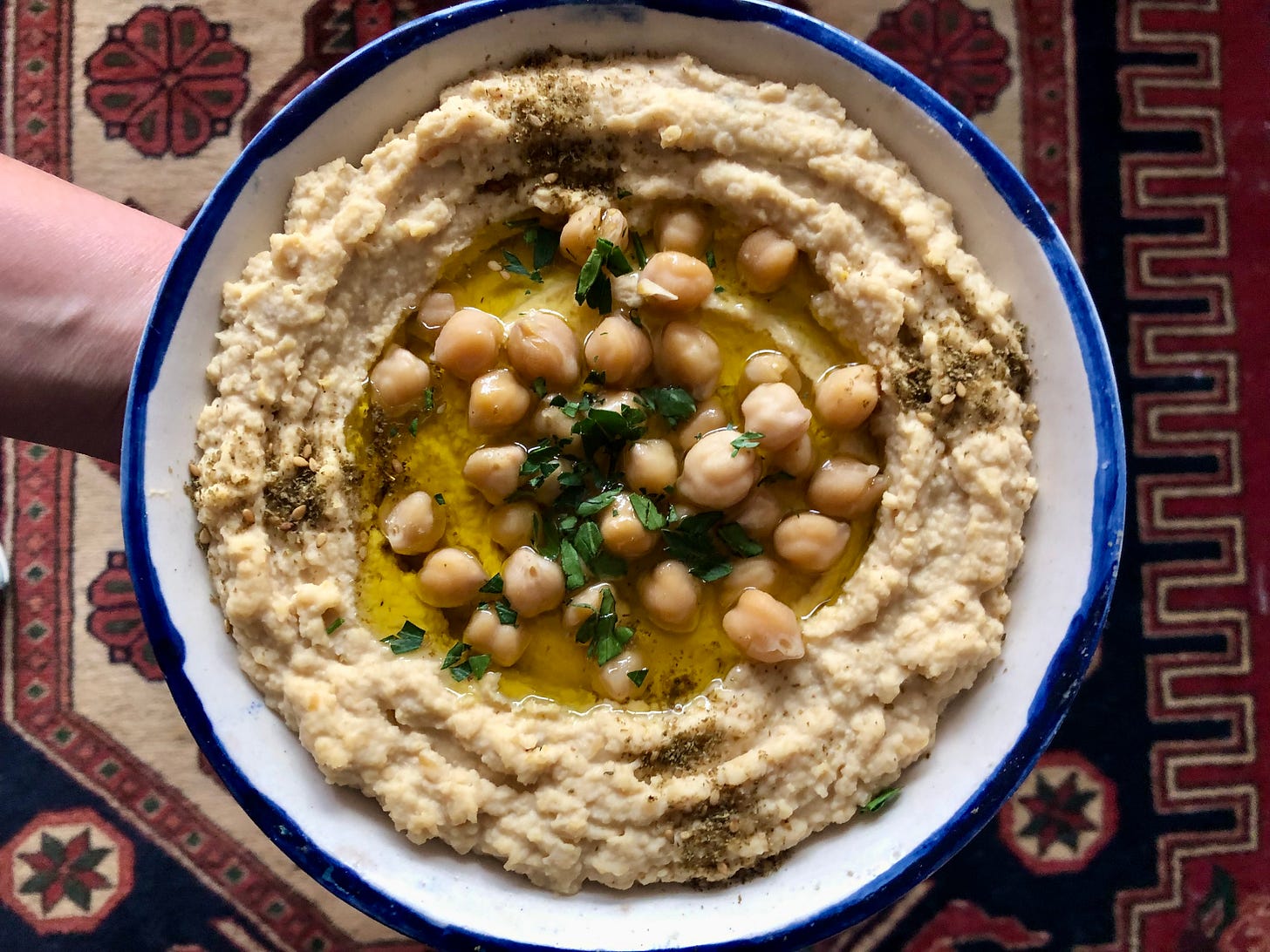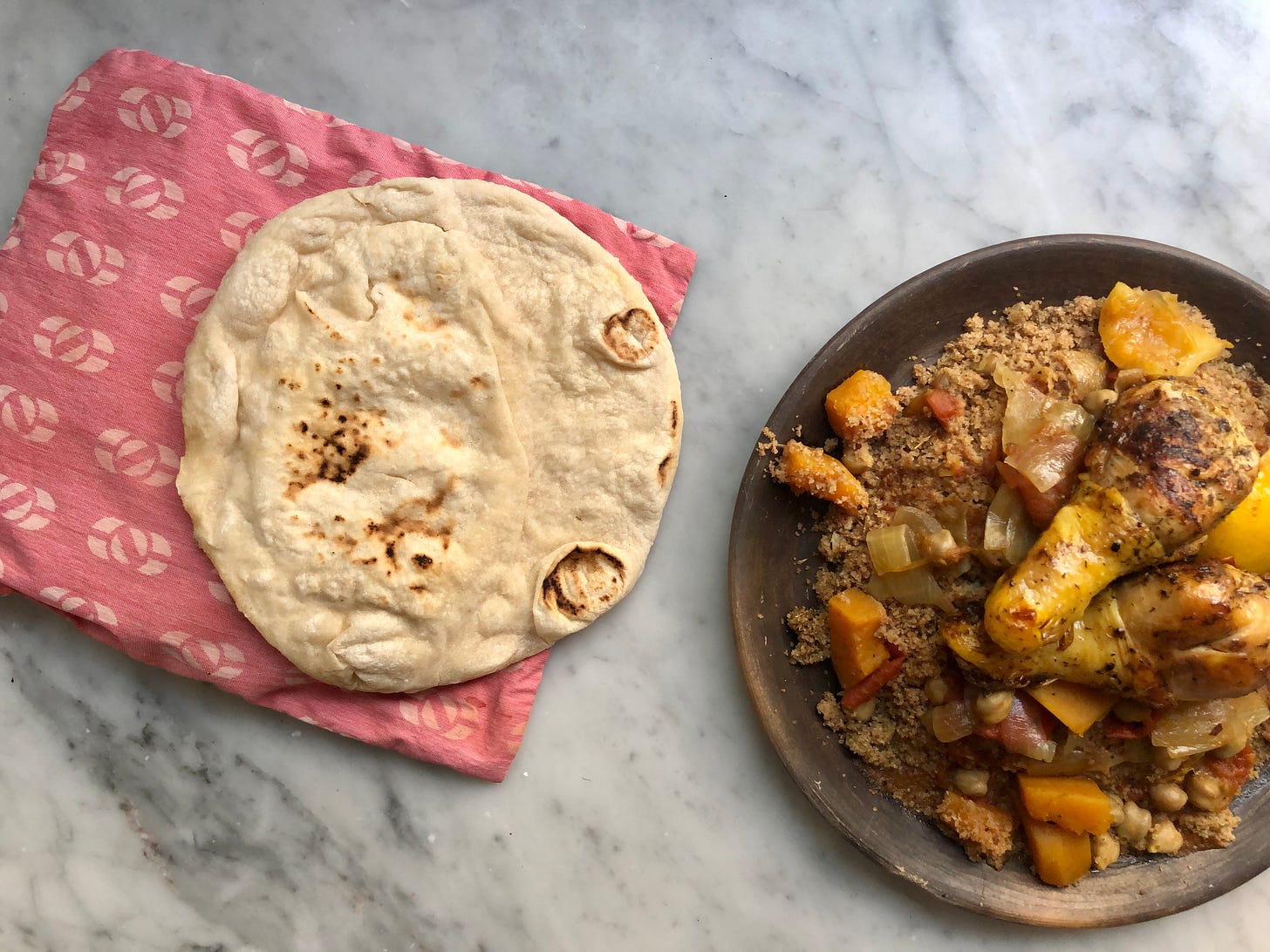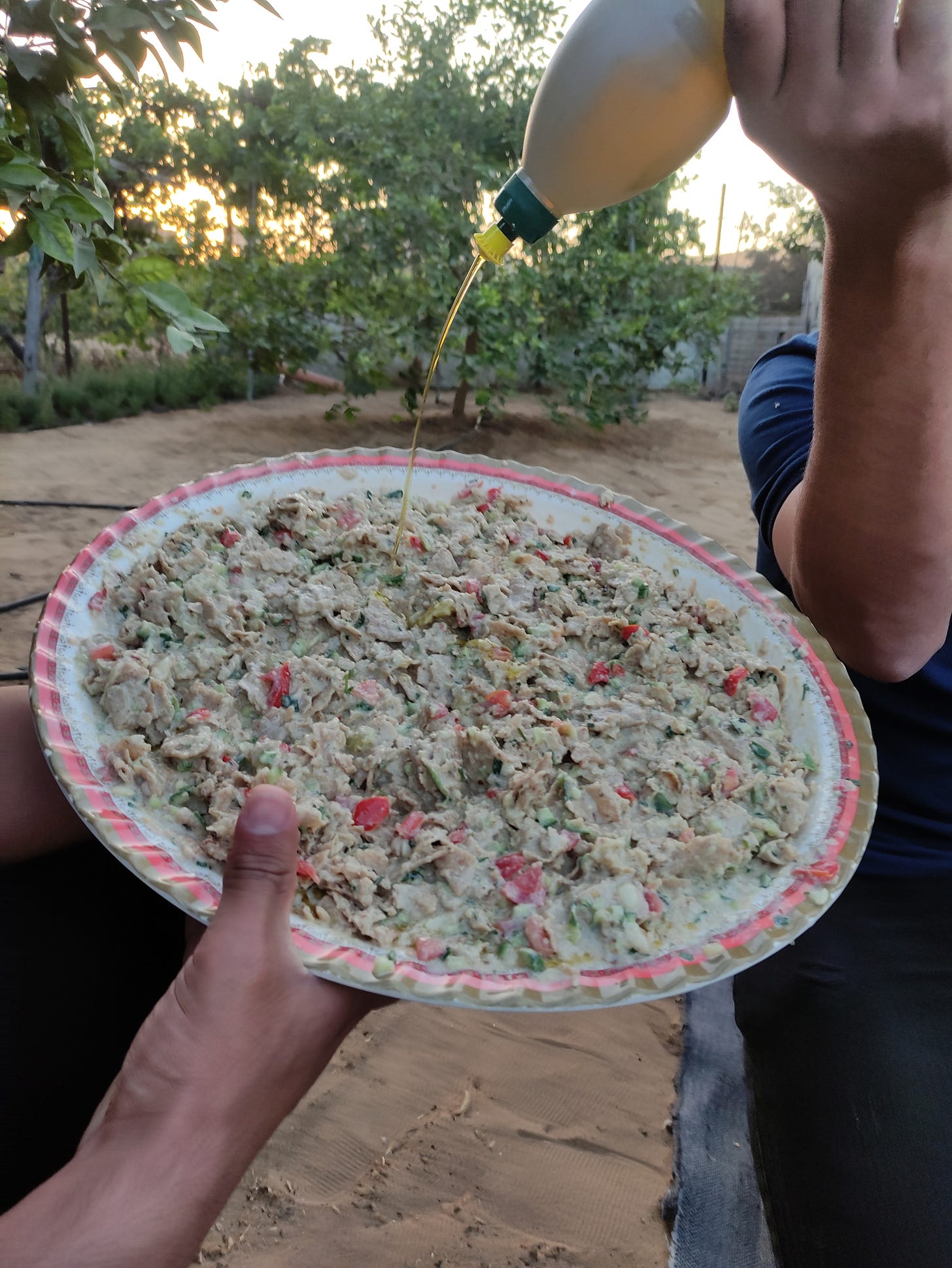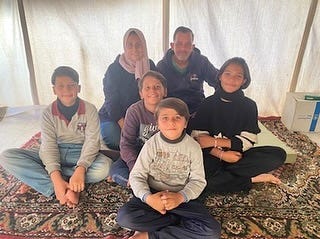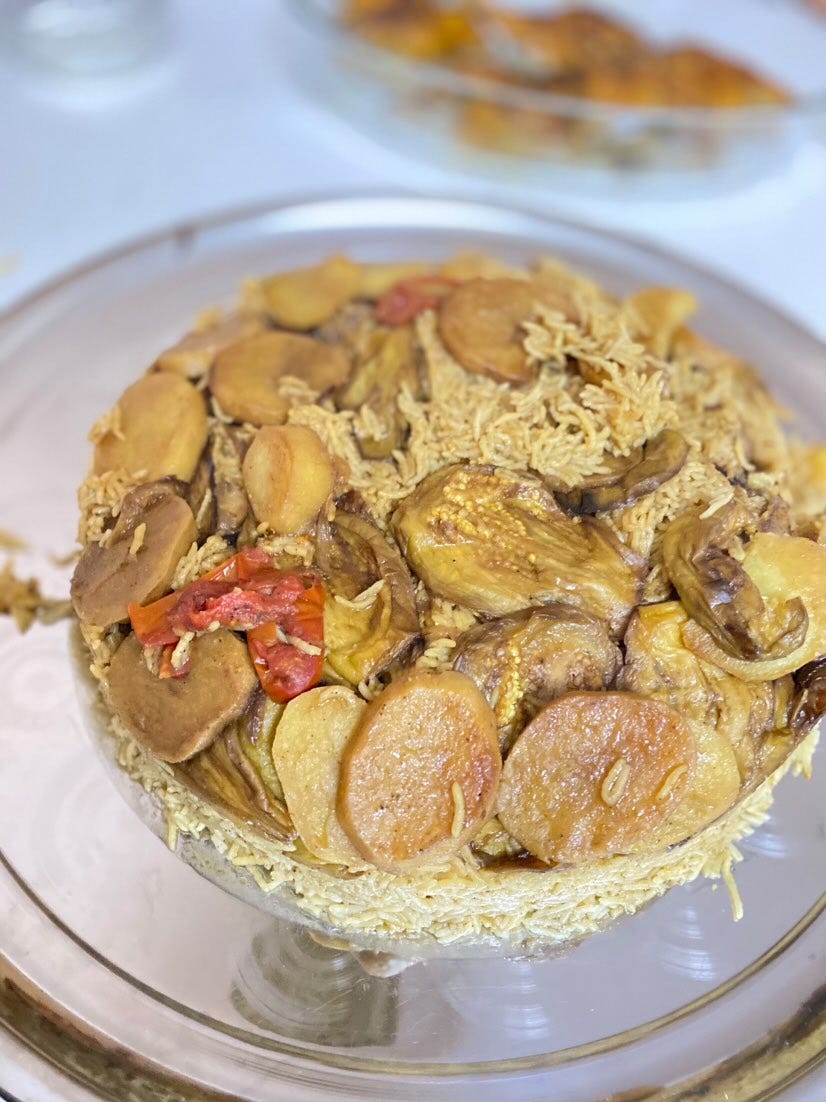Unexpected Encounters, Deep Connections: From Pastor to Maqluba.
A Culinary Journey Between México and Palestine.
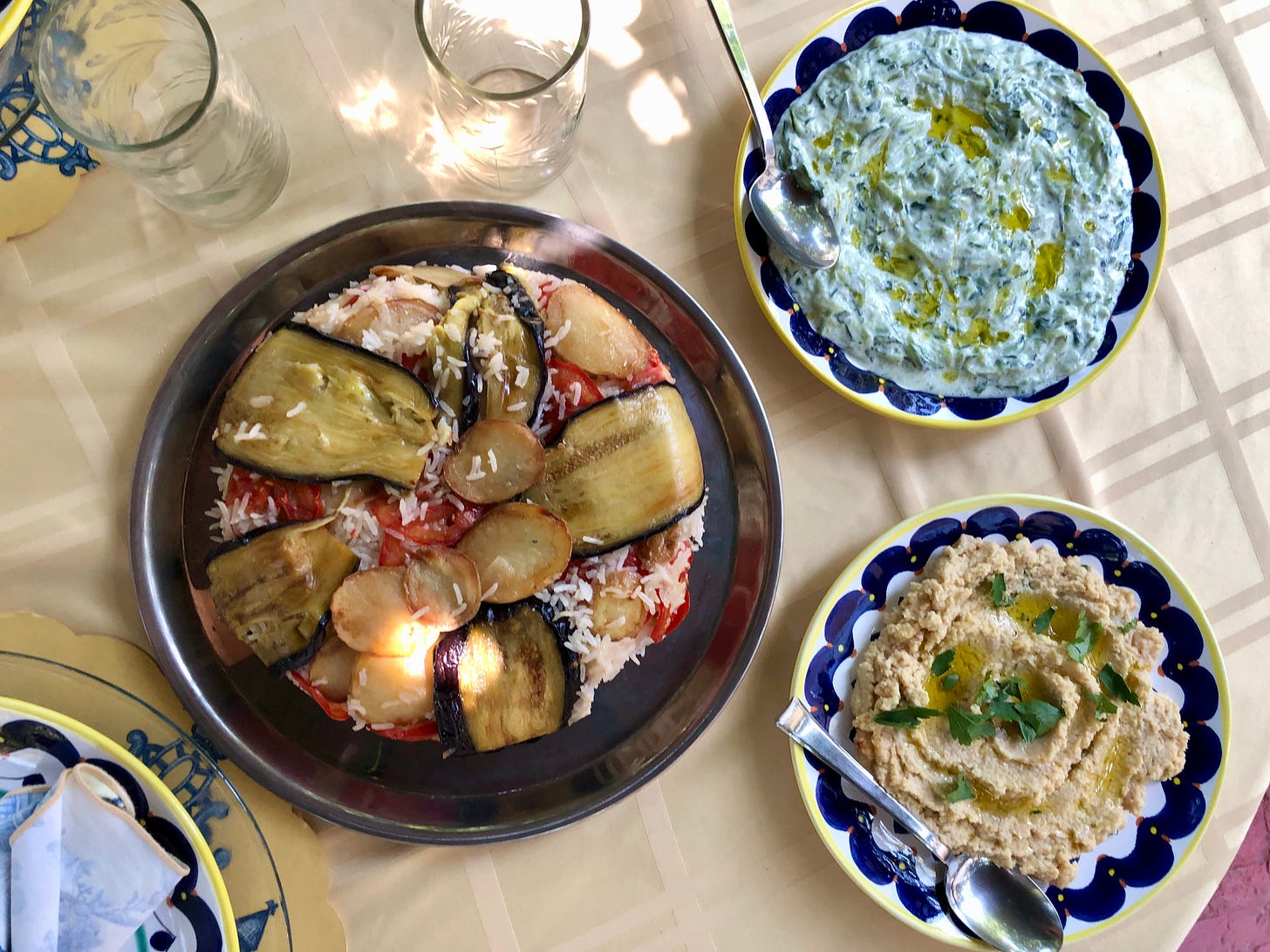
Unlike people, food does not lie. Learning to read it is a powerful tool for understanding the world we live in without imposed narratives. But to do so, we must surrender to its guidance: let it reveal the path and decipher its language step by step, using intuition and our senses.
In my case, the journey that began in my beloved hometown with tacos al pastor led me to shawarma, then to Khorasan (modern-day Afghanistan) —in the time of Mahmud of Ghazni— where this rotating roasting technique was first documented in an Ottoman miniature from 1616. From there, with a little jar of tahini in my bag, I jumped to the Levant in search of hummus and landed in its heart, Old Jerusalem, at Lina Café (considered the best hummus spot in the region by some locals), where they serve a popular version of this other millennia-old treasure whose secret ingredient is none other than chile verde.
Finally, chile verde took me to Gaza, where, to my surprise, the inclusion of this Mesoamerican ingredient is not an isolated case but a widespread custom —as Leila El-Haddad describes in her wonderful book The Gaza Kitchen:
How Gazans developed this love affair with the chile pepper is a culinary mystery for the ages. Whereas Lebanese cooks tolerate no spicy heat at all and cooks from other parts of Palestine and the greater region use spice in moderation, Gazan cooks (specifically those from Gaza City itself, as opposed to rural areas) make you sweat, whether using a local variety of fresh hot green chile peppers —generally crushed in a mortar with lemon and salt—or else ground red chile peppers conserved in oil and sold as a condiment and ingredient called filfil mat’hoon.
As El-Haddad adds, chili is not only appreciated in Gaza for its flavor, but also —due to its ease of production, low cost, and high vitamin and mineral content— it plays an important nutritional role, especially in low-income communities, where it is even included in school breakfasts in the form of filfil mat’hoon sandwiches.
This unusual attachment of Gazans to spicy food was the first thing that caught my attention about this particular Levantine cuisine, not only for its taste but also because this trait is a clear example of the shared codes between geographically distant cultures that I emphasized in my previous entry. In Gaza, as in Mexico, regardless of the kilometers that separate us, chile is not just a seasoning—it is also a symbol of resistance.
My first approach to Gazan cuisine—before even discovering El-Haddad’s book (thanks to this episode of Parts Unknown by Anthony Bourdain)—was through a vlog by Easy Arabic, where the now award-winning Palestinian journalist Bisan Owda asks people—many of whom we don’t know if they are still alive—on the streets of a Gaza that now lies in ruins, about the dishes they consider most representative of their culture. Based on their responses, I compiled a list of the most frequently mentioned recipes and recreated some of them in various entries of this newsletter (a list is below), drawing theoretical support from Leila El-Haddad’s book as well as other books and online materials (such as this video on the preparation of Maftoul).
Recreating these recipes and learning their stories only made it more evident to me how ancestral values connect Gazan and Mexican gastronomy—through their Mesoamerican and Canaanite cultural roots—and how remarkable it is that both have managed to preserve these practices despite centuries of colonial domination.
By ancestral values, I specifically refer to three fundamental pillars that are shared between both gastronomies—which I will analyze individually in my upcoming entries: their relationship with Mother Earth, where cultivation is not just production but also rootedness and resistance; outdoor cooking and street food, which reflect the democratic access to good food and the communal space as an essential part of daily life; and finally, the ritual and healing dimension of food, where cooking and eating are not merely biological acts but forms of connection, memory, and healing.
While my initial attraction to Palestinian cuisine was its shared love of spice with ours, what made me stay was its ability to understand food as something beyond a commodity—especially in times when "dominant" cultures focus primarily on transactional pleasures and instant gratification. One detail that immediately stood out to me in Bisan’s Easy Arabic vlog was the distinction that some people made between dishes served on happy occasions and those reserved for sad moments. More than just a simple list of recipes, this categorization felt like a kind of emotional map, a symbolic language in which food reflects the highs and lows of life and people's relationship with their surroundings.
Ironically, the Gaza we see in those images—the Gaza that so generously shares its culinary traditions in front of the camera—no longer exists. This realization marked a before and after in my research.
When I wrote my last post before my long break in this newsletter—on September 4, 2023—titled Chile y Limón: A Love Letter to Palestinian Cuisine—I was not unaware of the 77 years of Zionist occupation in that nation
(If you want a good cinematic document about the tragic event that started this ordeal—known as Nakba—I recommend watching Farha. And if you still don’t understand the difference between Judaism and Zionism, I recommend this and this video, and this interview). Here is a brief summary, because an update is always necessary:
Until the early 20th century, Palestine was a land where Muslims, Christians, and Jews coexisted peacefully, until the fall of the Ottoman Empire. After World War I, the United Kingdom took control of the territory and, with the Balfour Declaration (1917), supported the creation of a “Jewish national home” without consulting the Palestinian population, which made up over 90% of the inhabitants. In 1947, the UN approved a partition plan granting 55% of the land to a Jewish state and 45% to an Arab state, but Palestinians rejected it as it was imposed without their consent. In 1948, with the proclamation of the State of Israel, the Nakba (the catastrophe) began: more than 750,000 Palestinians were forcibly expelled from their homes, 500 villages were destroyed, and at least 15,000 people were killed in systematic attacks, such as the Deir Yassin massacre. In 1967, Israel occupied the West Bank, East Jerusalem, and Gaza, imposing a control system that persists to this day. Gaza has been under total blockade for 17 years, with severe restrictions on access to essential goods.
Over these 77 years, the occupation has resulted in forced displacements, land confiscation, systematic repression, political imprisonment, assassinations, and complete impunity by the Israeli government. [No Other Land, the documentary recently awarded at the Oscars, is a valuable contemporary testimony of this situation].
Until that September 4, I was also not unaware of the escalating violence in the region following Benjamin Netanyahu’s return to power. But the terror that unfolded just 33 days later—and that resumed just over a week ago—goes beyond any prediction.
This entry and the next three are an attempt to bridge the gap between my last post on September 4 and the present, to make sense of the global psychosis we are living through (including the state of violence in Mexico, which will undoubtedly be part of this analysis). It is also a way—from my own trench, which is the kitchen—to add a small grain of sugar to help raise awareness and foster empathy for the cause of this people who, through their extraordinary cuisine, touched my heart, and whose resilience in the face of extermination has opened my eyes and transformed my perception of the world forever.
As rapper Macklemore says in this speech, which well expresses my feelings over the last 16 months:
I want to live in a world where standing up against genocide isn’t brave it’s human.
These months of research on Palestinian cuisine have not only connected me, through social media and other outlets, with the work of journalists, documentary makers, intellectuals, artists from all fields, activists, and Palestinian cooks, but I’ve also made friends with people currently in Gaza with their families, surviving bombings, displacement, food scarcity, cold, rain, lack of a roof, a bed, clean water…
Like Rasmi, a young student from Khuza in southern Gaza, who before the genocide was studying Multimedia Technology and Web Development at the Islamic University of Gaza. After being displaced several times, Rasmi and his family finally managed to return to their home during the ceasefire, and although they found it in ruins, they were hopeful they could rebuild it. But that hope died a few days ago when the bombings resumed, and the Israeli military once again drove Rasmi and his family off their land, forbidding them to return. Right now, Rasmi is raising money not only to eat — food is scarce and prices are sky-high — but also to pay for fuel to get to a more “safe” area (if such a thing exists in Gaza).
Here’s his PayPal account; any help could save his life. It wont take much of your time.

Or like Sohad, who is a mother and cook like me, and before the genocide, had her own brand of preserves and shared recipes on social media. Before being displaced and her home being bombed, Sohad had what she considered perfect and happy with her daughter, three sons, and her husband in the north of Gaza, in Abu Mazen. During the ceasefire, Sohad also had the chance to return to her home, and although only the shell of it remains, she is willing to stay, rebuild it little by little, and bring back some normalcy to the lives of Rehab, Muhammad, Taim, and Adam, along with her husband, Saed.
Here’s a link to her Chuffed account, to help her cover her family’s basic needs while they have no other means of generating income.



